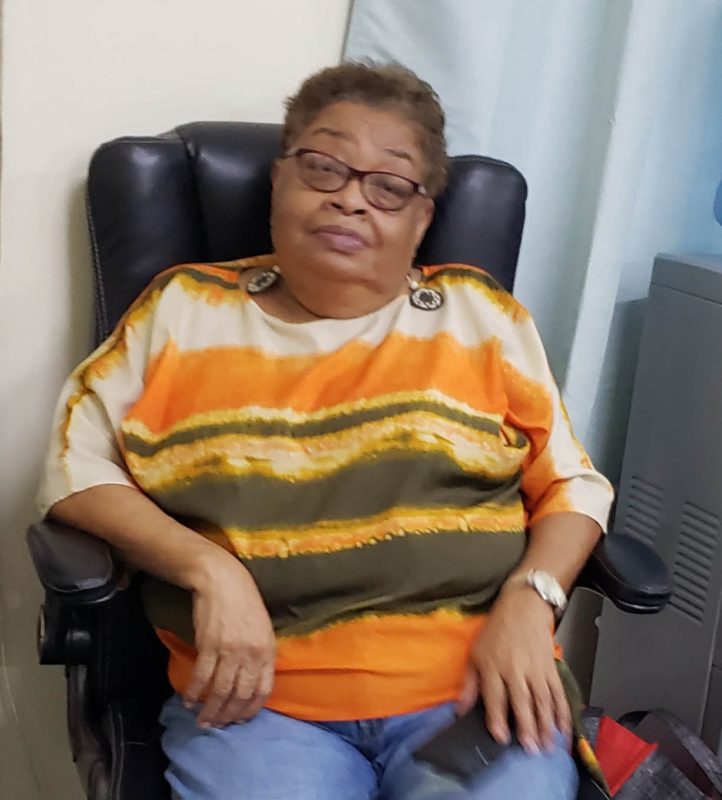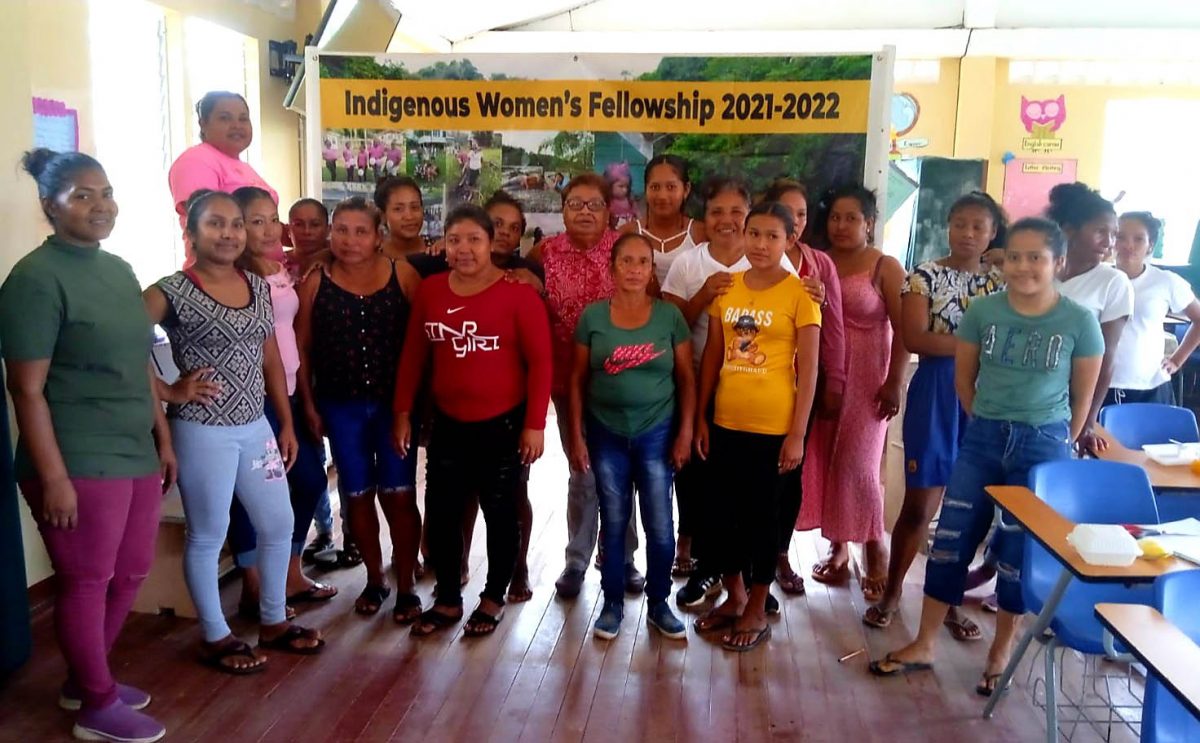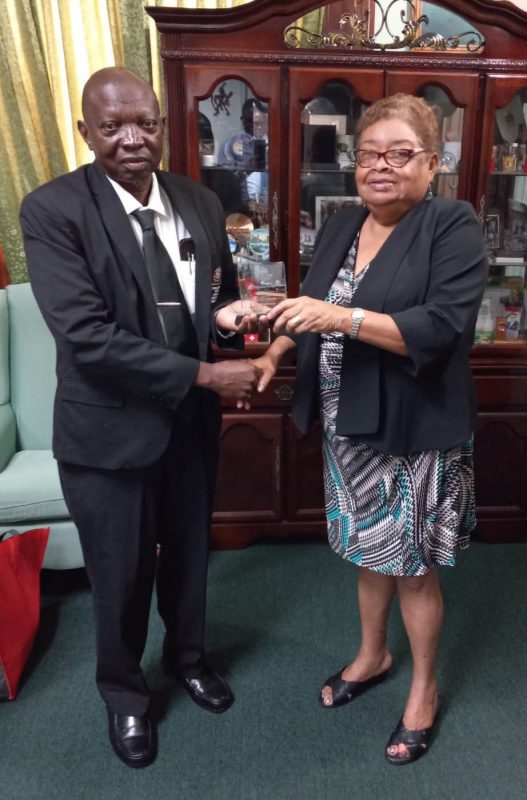Educator, former politician, now capacity building and community engagement consultant Patricia Fredericks, 71, leaves indelible impressions wherever she goes. Though she is originally from the small predominantly Carib village of Kwebanna on the Waini River in Region One, she says, “When people ask me where I’m from, I usually tell them I’m from Regions One, Four and Nine.”
Born in the Moruca sub-region, Fredericks attended the primary schools at Kwebanna and Santa Cruz but completed her primary education at Santa Rosa. She recalled that her parents had moved to Santa Cruz, Barama Mouth to work on a sawmill, taking their children with them.
The headmistress of the school, Carlotta Persaud, Fredericks said, “saw some potential in me and advised my parents to enrol me at Santa Rosa, a higher level school. They agreed. The first place I stayed was at ‘Gramma Natty’ at Cabucalli Landing. The place became crowded and ‘Auntie Shan’ (Shandrina De Souza) took me in. I wrote the Preliminary Examinations and College of Preceptors while I was at Auntie Shan.
“There wasn’t a proper road from Kumaka in Santa Rosa to Kwebanna in those days and my parents hired a launch from Mr Farnum at Barama Mouth to take me to and from Santa Rosa for school and the holidays. It took a whole day of travel by the launch which was powered by a Petter engine. Sometimes we travelled on the tractor head on the track linking the two communities. Fishing boats came to Cabucalli landing and Auntie Shan used to send us to buy fish, bush meat, turtle meat and turtle eggs. It was only after I started doing conservation work I realised I was contributing to the demise of marine turtles.”
Fredericks recalled being the first Anglican student to attend Santa Rosa Primary which was a Roman Catholic School in those days. At that time it was run by the Sisters of Mercy. “I am grateful for their teaching and influence on who I am today,” she said. “They and my parents taught me I must have patience and impart my knowledge. Even though I am 71 years, I have more to give and I’m sitting here thinking how much more I can give before I pass. My teachers Kenneth La Rose and Cecil Rodrigues were disciplinarians. If it wasn’t for them I might not have learnt the things I did.”
Since Auntie Shan was a Roman Catholic, Fredericks said, “I went to mass at Santa Rosa RC Church. I did everything at the church except taking communion. I didn’t feel strange being Anglican in the Catholic church. I used to help Auntie Shan launder the vestments for the priests and the altar boys.”
Every year in May, the church observes a ceremony called the Coronation of Mary, mother of Jesus Christ. “The fifth form chose me and Carl ‘Long Carl’ Rodrigues to crown Our Lady,” she recalled. “There were objections from some senior citizens in the community because I was not Catholic. The nuns held out. I had to dress like a bride. Eventually, people came around. I was happy and proud. I used to attend church more regularly than most of the Catholics around because of Auntie Shan.”
Fredericks enjoyed her school years and fitted in well with the community. “Everything was simple then. I did a lot of sports. At Santa Rosa I learned Amerindian dances. Every Friday we had to do classes in Amerindian dances. We called it banchikelli. Isabella ‘Ma Bella’ Atkinson from Acquero taught us the dances. Every Friday night there was a banchikelli session at John ‘Dinch’ Abrams place at San Jose and Auntie Shan took me. I was a teenager. I loved that. She took me almost everywhere she went,” she said.
At Santa Rosa, Fredericks learned to paddle corials (dugouts). “Everywhere we wanted to go we had to paddle. Even though I cannot ride a bicycle, I can paddle a canoe very well,” she said. “It was a change when recently I went back to Moruca after decades to see the taxis on the roads and water taxis. In my days it was all paddle boats. That was a big change. Road links are all over from Acquero to Kumaka … and Waramuri and Kumaka to Kwebanna.”
After leaving school, Fredericks taught at Kwebanna Primary, Santa Rosa Primary and Waramuri Primary in Region One and in later years at St Ignatius Secondary and Arapaima Primary in Region Nine.
From Santa Rosa she went to Cyril Potter College of Education. While teaching at Santa Rosa she got married and gave birth to her three daughters.
“What I remember most is the camaraderie between the villages in Moruca,” she told the Stabroek Weekend. “People from Kwebanna and Waramuri would come to Santa Rosa and vice versa to play cricket. We used to organise concerts. I was always working with young people, women and forming a sports group here, a cultural group there and a women’s group here and there. That was what I liked doing apart from teaching. The cultural activities helped a lot of young people during that period when there was not much to do and the children looked forward to that.”
In 1978 she was sent to Waramuri Primary as acting head teacher. “That was another experience. My children were with my mom. There were two other teachers who were former students of Santa Rosa Primary and we had to live in a small apartment,” she recalled.
On reflection, she said many of her past students are professionals and leaders wherever they are. “At Santa Rosa I was one of many who advocated for the bridge linking Kumaka and San Jose. I was one who suffered from access to get across the river to school and was there when the first bridge was built. I was teaching there when Santa Rosa Primary moved from just academic classes to include technical vocational subjects like home economics and industrial arts. I was teaching there when the school changed from being run by the church to government run. Those were milestones I experienced,” she said.
Political groundings
In 1980 Fredericks took a change in profession from teaching to politics and moved to the Rupununi where she spent 38 years, most of her working life.
How did she get into politics? Her mother, Gertrude Fitzpatrick, the first woman Amerindian captain/toshao in Guyana, influenced her to become involved in community work and political activism. Fitzpatrick was a supporter of the People’s National Congress (PNC) at the time.
“I grew up seeing her do community work and getting the women to do things to help themselves. Her father, Johnathan Jackson, was the captain/toshao for Kwebanna before her. I grew up seeing them doing community work. Even though I was a teacher at Kwebanna I did a lot of community work with a focus mainly on sports, culture and sewing classes with the young people and the women. My grandmother, Elizabeth Jackson, was the first teacher at Kwebanna Primary. My father, Wilfred Jackson, supported my mother. She could have gone to meetings in the village and he would look after our little cake shop, cook and generally supported her at the home level. At that time meetings and conferences were rare in Georgetown but when she had to travel, she did,” Fredericks said.
“A big thing for her was being on the board of directors for the Guyana School of Agriculture. I patterned myself after her. All of my siblings were involved at community level as members of the culture and sports groups. I went further to become more involved in politics at the regional and national levels because of exposure, initially at Santa Rosa and being a teacher I suppose. When I became politically involved I was voted as group secretary or district secretary.”
Because of her political activism she travelled to the other districts, Mabaruma and Matthew’s Ridge, in the region for party conferences. “During the conferences we made presentations and staged cultural shows. That helped to prepare me for public speaking,” she noted.
In 1980, Fredericks was offered a job as regional supervisor for Region Nine with the PNC by then regional minister Fitz Carmichael.
At the time she was going through a separation and moved with her children. It was during the height of the campaign for general and regional elections. “Within a month of me getting in Region Nine, I visited every village including Konashen. I went to the Rupununi on September 19, 1980. Elections were held in December that year,” she recalled.
After the elections she became a Member of Parliament and served in that post for five years. In January 1986 she was sworn in as the Regional Chairman for Region Nine, a post she held until October 1992.
“Even if you leave out me being the first Amerindian female chairman, I was the first female chairman in Guyana to hold that post. There was a female deputy in Region Ten at the time and nine male chairmen. I never felt uncomfortable with them. I always felt from small, I was equal to boys and later men,” she stated.
She noted that it is said that politicians lie a lot. “As a politician I was careful not to lie. I always felt we should be honest. The other thing I tried to do was to not make promises I couldn’t keep. I was always looking at people and what was good for them. I always respected village councils. Even now if I have to go into the villages, I inform them of my intentions. I never said I am this or I am that. That doesn’t help,” she expounded.
She credits improvements in Region Nine during her tenure to the team she worked with. She was instrumental in ensuring there was 24-hour water supply to Lethem Hospital. There were many other things she wanted to do but funding was always an issue.
After the PNC lost the elections, she returned to teaching in 1993 at St Ignatius Secondary where she taught for five years and at Arapaima Primary for two years.
When she left teaching, Fredericks fostered ten schoolgirls from various villages, who had no place to stay but were eligible to attend St Ignatius Secondary. “My home was quite big. They were from North Rupununi, South Rupununi including one from Konashen. They are doctors, nurses, professionals [now],” she said.
Her daughters obtained their secondary education in Georgetown. “Yes, I know they missed certain things compared to children who had their parents with them all the time. I tried my best. They understood to an extent because I was on the move all the time. I was never one to sit in an office,” she explained.
Living at Lethem called for some financial management, she recalled. “We had to fly to Lethem because the road was virtually non-existent. I remember when I went there I hadn’t money. The first Christmas we ate corned beef and rice. Coming from Moruca, where things were cheaper it was hard to manage money but I had to learn. That was a big adjustment for me. The culture was a bit different, the way people speak and the food but I adjusted quickly. I got used to eating farine,” she said
Consultant
In 2000, Fredericks joined Conservation International as its education and awareness coordinator. “It was challenging as Conservation International was new to the area at the time. I taught resource management and stuff like that to adults. I led the Kanuku Mountains Protected Area process. I worked with a team to convince people there was a need for a protected area,” she explained.
Fredericks left Rupununi in 2008 and took up residency on the coastland which she has now made home. In 2009, she started a private consultancy with a focus on capacity building, community engagement and facilitation skills. Since then she has done consultancies with the World Wildlife Fund and Guyana Forestry Commission among other clients.
She is currently a mentor on the Amazon Indigenous Women’s Fellowship Programme sponsored by Conservation International, and in November/December last year she completed a
women in governance mentoring programme with women toshaos for the Ministry of Amerindian Affairs.
“Right now I am doing a capacity building assessment for an organisation called Neo Terra in capacity building and needs assessment for the Upper Mazaruni District Council and the North Pakaraima District Council,” she said. “Sometimes I am asked to assist in other consultancies and sometimes I ask others to assist in mine.”
She assisted in the consultation for the Shell Beach Protected Areas.
“Now as a consultant, I don’t do politicking,” Fredericks said. “I do what I have to do according to my terms of reference. I had enough of party politics to last me the rest of my life. You won’t find me in party politics even as I’ve changed political allegiance. But whatever I do I still work for communities.”











